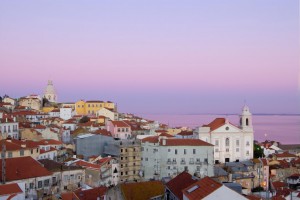Explore the best of the entire Iberian peninsula on one spectacular journey, discovering how Moors, Jews and Europeans influenced the culture, cuisine and arts of Spain and Portugal.
Elciego
Elciego
Elciego is a town that dates back to 1067 centered within the La Rioja wine region located in the southern province of Alava, Northern Spain. Famed for its Marques de Riscal Winery, the property includes its own hotel designed by renowned architect, Frank Gehry who, like many of his other works, built the entire structure with titanium adding hints of pink and gold tones that compliments the winery’s color palette. Most tours held at the Marques de Riscal Winery does not feature a visit to the hotel, however visitors are welcomed at the historic establishment of Agroturismo Valdelana which also houses a winery from the 15th century. September is a popular month to visit as the town celebrates the Rioja Wine Festival of San Mateo just outside of Elciego.
|
|
Cordoba
Cordoba
Today's Cordoba is as impressive and surprising as its past. In the 11th century it was one of the most important capitals in Europe. People of the most different cultures and religions - Jews, Muslims and Christians - have lived peacefully together, and important philosophers, scientists and artists emerged from here. Cordoba has interesting aspects, including its great monuments - the world-famous Mezquita, the Moorish mosque - and museums. Cordoba is as a lively town in the best Andalusian tradition, a town of Flamenco and bullfighting, and one of the most attractive destinations in southern Spain. The Great Mosque, which took up Roman architectural traditions, made use of columns from older buildings around, and added the Muslim sentiment of the abstract and the limitless room. The double arches are representative for the architecture dominating North Africa. Another splendid example of Muslim inheritance in Spain is the old Ummawiyy castle, Alcázar. The main attraction here are the gardens, lavish, extensive, and with water in a central role.
|
Destination Guide
|
Evora
Evora
Evora is considered a seat of learning with its University founded in 16th Century by Cardinal Dom Henrique. Within the surrounding wall the most prominent feature is the 2nd or 3rd Century ruins of a Roman Temple dedicated to Goddess Diana. Another attractive feature is the 15th Century Convento dos Lóios. The city’s 13th century cathedral took 50 years to build and is reminiscent of a fortress. The main square with its 16th Century fountain has a sad history. Among other events, Dom João II witnessed the beheading by his orders of his brother-in-law. Equally unpleasant were the sights caused by the Inquisition in this public place. A macabre reminder is the Capela dos Ossos in the 15th Century Igreja de São Francisco - where the bones of 5,000 monks lie. There are several museums - the Museu de Arte Sacra, Galeria de Arte Casa Cadaval, the Museu de Artes Decorativas Religiosas and the Museu de Évora. The museum, formerly the palace of the Bishop, built with many worked stones from previous buildings in the city, has some outstanding religious items.
|
Destination Guide
|
Barcelona
Barcelona
Barcelona, the self-confident and progressive capital of Spain, is a tremendous place to be. Though it boasts outstanding Gothic and Art Nouveau buildings, and some great museums – most notably those dedicated to Picasso and Catalan art – it is above all a place where there's enjoyment simply in walking the streets, stopping in at bars and cafés, drinking in the atmosphere. A thriving port and the most prosperous commercial centre in Spain, it has a sophistication and cultural dynamism way ahead of the rest of the country. In part this reflects the city's proximity to France, whose influence is apparent in the elegant boulevards and imaginative cooking. But Barcelona has also evolved an individual and eclectic cultural identity, most perfectly and eccentrically expressed in the architecture of Antoni Gaudí. Scattered as Barcelona's main sights may be, the greatest concentration of interest is around the old town (La Ciutat Vella). These cramped streets above the harbor are easily manageable, and far more enjoyable, on foot. Start, as everyone else does, with the Ramblas.
|
Destination Guide
|
Bilbao
Bilbao
Bilbao, the capital of Vizcaya Province, lies seven miles from the sea and has a coastline featuring rocks and steep cliffs, creeks and small estuaries; small fishing villages nestle in the inlets below green hills. The port of Bilbao is the largest in Spain and is built against the mountains. The city's fine museums include Fine Arts Museum and Guggenheim Museum. The Guggenheim Bilbao Museum is devoted to American and European art of the 20th century. The Fine Arts Museum specializes in paintings by Spanish masters. Our Lady of Begona Church is a 16th-century church on a hill with a good view of the city and valley. Diocesan Museum of Sacred Art is located in an old convent of Dominican nuns, a 16th-century, L-shaped cloister housing this fine museum with an outstanding exhibit of silversmiths' crafts that is one of the best collections in Spain. The Bullfighting Museum shows interesting bullfighting paraphernalia, such as costumes, photographs of famous toreros and a collection of posters. Visitors can try their gambling luck at Gran Casino Nervion.
|
Destination Guide
|
Madrid
Madrid
The capital of Spain since 1562, Madrid is located on the geographic center of the Iberian Peninsula. Because of its central location and high altitude, the climate of Madrid is characterized by warm dry summers and cool winters. Madrid is a city of great monuments. Among its highlights are the medieval center dating back to the Habsburg Empire and the Prado Museum. Madrid is not just a cultural destination. It is also a lively metropolis with many pubs, cafes, discotheques and nightclubs open late into the night.
|
Destination Guide
|
Granada
Granada
Granada is located at the foot of the Sierra Nevada Mountains of Andalusia, Spain. Granada has been inhabited by many empires for 2,500 years from the Greeks, Romans, Visigoths and the Moors. Remainder of each reigning era is prominent in Granada’s cultural and architectural influences. Imprints of the past can be found in Albaicin, an old Arabic quarter paved with cobble stoned streets, ogee arches, voussoirs, and decorative tile work. When the sun sets, Alhambra is at its most beautiful and radiant complimenting Byzantine courtyards and muqarna details. Homes also reflect the Mediterranean and Renaissance elegance long past. Present-day Granada attracts visitors by recapturing the past and evoking the co-existence of different cultures.
|
Destination Guide
|
Seville
Seville
Seville is one place most beloved by visitors to Spain. Although today Moorish influence is architectonically most evident - Andalusia was occupied by Moors for about 800 years - it has been a cultural center long before. Seville was home of famous and infamous figures of history, the legendary "Don Juan" started from here to conquer the hearts of women across all Europe, while Columbus started from a port close to Seville to discover a new world. Prosper Merimée's "Carmen", who couldn't make her decision between the officer Don José and the bullfighter Escamillo, can still be watched today in opera houses. Seville is the very heart of Andalusian culture and the center of bullfighting and Flamenco music. Take it easy and interrupt sightseeing from time to time to have a few "tapas", those typical "small spanish dishes", and a glass of Sherry wine in one of the many bars in this city.
|
Destination Guide
|
Lisbon
Lisbon
Portugal’s capital is an 18th-century city - elegant, open to the sea and carefully planned. Most places of interest are within easy walking distance. Rossio Square, the heart of Lisbon since medieval times, is an ideal place to start exploring. Many rebuilt houses with original façades provide stores and restaurants with modern interiors. High above Baixa is Bairro Alto - with its teeming nightlife. There are many monuments and museums, such as San Jeronimos Monastery, Royal Coach Museum and Gulbenkian Museum. Two well-known landmarks are the Monument to the Discoveries and the Tower of Belem. A statue of Christ looms above Europe’s longest suspension bridge. Madragoa, Bica and Bairro Alto, Lisbon’s older sections, offer a variety of sights: the Church of Sao Roque, with its beautiful tiles; St. George Castle, which offers a splendid view from its location above the Alfama quarter; the botanical gardens, featuring an unusual, cold greenhouse; and the cathedral, stunning with its Moorish design. Renowned Gulbenkian Museum is the cultural center of Portugal.
|
Destination Guide
|






